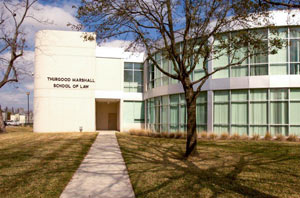THE UT AUSTIN SEGREGATION LAWSUIT THAT MADE TSU HOUSTON’S FIRST PUBLIC UNIVERSITY  A recounting of some Houston higher-ed history comes from Ben Werlund this past weekend — namely, how University of Houston and Texas Southern University ended up as separate but adjacent public universities in the Third Ward. In 1927 the schools were founded as Houston Junior College and Houston Colored Junior College, segregated schools that eventually wound up on neighboring land after being renamed University of Houston and the Houston College for Negroes. In 1946, black Houstonian Heman Marion Sweatt was denied admission to all-white UT Austin’s law school; as the resulting lawsuit worked its way up to the Supreme Court in the pre-Brown v. Board of Education landscape of separate-but-equal requirements, the state quickly bought and renamed the Houston College for Negroes and added a law school, trying to prove that black students had comparable options to the Austin campus. “And thus, Houston’s first public university was born,” writes Werlund, to keep the Texas school system “from having to integrate its flagship in Austin.” The Supreme Court, however, didn’t buy that the new Houston law offerings measured up to the nearly 70-year-old UT law program, and UT Austin had to admit Sweatt after a 1950 ruling. TSU law professor James Douglas tells Werlund that the state legislature proceeded to cut TSU’s budget by 40 percent the next year; the private all-white University of Houston didn’t start to admit black students until 1962, shortly after which it turned public. “This was in the ’60s,” notes Douglas — “In 1964, I don’t think the people in Austin really thought integration was going to stick . . . I don’t think they ever thought this whole idea of having 2 universities close to each other was ever going to be a problem.” [Houston Chronicle] Image of Thurgood Marshall School of Law at Texas Southern University: TSU
A recounting of some Houston higher-ed history comes from Ben Werlund this past weekend — namely, how University of Houston and Texas Southern University ended up as separate but adjacent public universities in the Third Ward. In 1927 the schools were founded as Houston Junior College and Houston Colored Junior College, segregated schools that eventually wound up on neighboring land after being renamed University of Houston and the Houston College for Negroes. In 1946, black Houstonian Heman Marion Sweatt was denied admission to all-white UT Austin’s law school; as the resulting lawsuit worked its way up to the Supreme Court in the pre-Brown v. Board of Education landscape of separate-but-equal requirements, the state quickly bought and renamed the Houston College for Negroes and added a law school, trying to prove that black students had comparable options to the Austin campus. “And thus, Houston’s first public university was born,” writes Werlund, to keep the Texas school system “from having to integrate its flagship in Austin.” The Supreme Court, however, didn’t buy that the new Houston law offerings measured up to the nearly 70-year-old UT law program, and UT Austin had to admit Sweatt after a 1950 ruling. TSU law professor James Douglas tells Werlund that the state legislature proceeded to cut TSU’s budget by 40 percent the next year; the private all-white University of Houston didn’t start to admit black students until 1962, shortly after which it turned public. “This was in the ’60s,” notes Douglas — “In 1964, I don’t think the people in Austin really thought integration was going to stick . . . I don’t think they ever thought this whole idea of having 2 universities close to each other was ever going to be a problem.” [Houston Chronicle] Image of Thurgood Marshall School of Law at Texas Southern University: TSU

